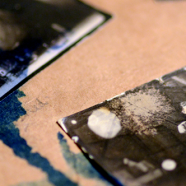
In telling the story of N.S.11 and her crew, eBay has been a fantastic source of material over the years. So, when a small, crumpled, ink-stained, single loose page from photo album appeared, this was one item we had to win. At just 7.5 x 7.0″ (190 x 180mm) this brown page, with five small photographs glued to each side, looked like it would yield not only some wonderful images, but with the pencil notes, some valuable information on the airship and its operational records. This we had to have. So, putting on a very healthy bid in the closing seconds of the auction, you can imagine the shock when we were outbid.
Concerned that this little piece of history would be lost for ever or worse still, broken up and each image sold separately, we contacted the seller in California and asked (pleaded) to be put in touch with the successful bidder. Whoever bought it must have been be serious about British airships and N.S.11. The seller kindly obliged and within hours the winning bidder was in touch, revealing himself as Paul Adams of the British Airship Museum at Cardington (BAMC) with a message that this little piece of history was not lost to N.S.11 after all. In fact, it would be sent straight to us to study. Once again, the fabulous worldwide community of airship experts and enthusiasts saves the day. Via Paul’s base in Boston, we now have the page in front of us.
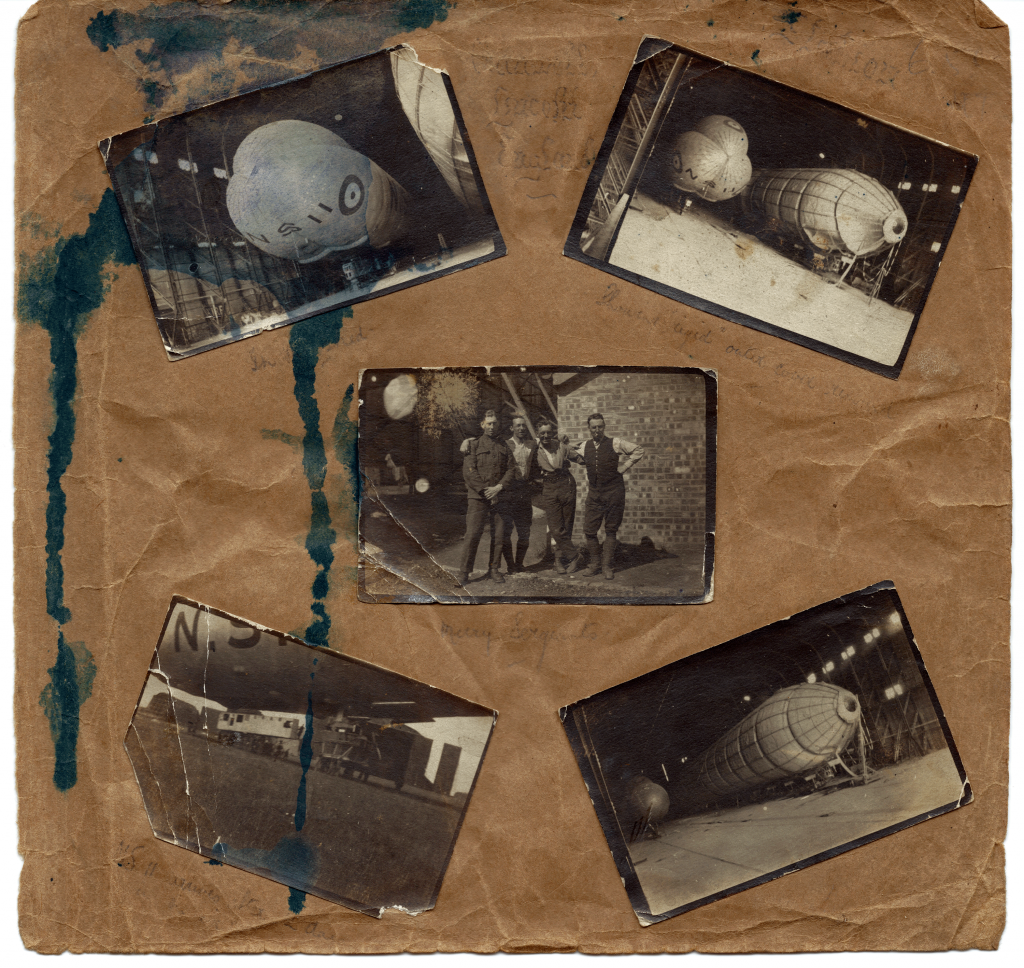 Let’s start by looking at ‘side one’. The pencil markings are very faint but this page is titled “Cranwell, Lincoln, England”. British naval airship expert Brian Turpin has already identified that from the girder pattern in the airship shed. Brian elaborates on this… “N.S.11 arrived at Cranwell on 31st March, 1919, from Kingsnorth via Pulham and Howden. The flight time is given as six hours, so it probably didn’t land at the other stations but just overflew them. She then remained at Cranwell until transferred to Pulham some time in June, 1919, but I don’t have a date for that only a flight time of 3 hours. She flew about 105 hours while at Cranwell during April, May and part of June.”
Let’s start by looking at ‘side one’. The pencil markings are very faint but this page is titled “Cranwell, Lincoln, England”. British naval airship expert Brian Turpin has already identified that from the girder pattern in the airship shed. Brian elaborates on this… “N.S.11 arrived at Cranwell on 31st March, 1919, from Kingsnorth via Pulham and Howden. The flight time is given as six hours, so it probably didn’t land at the other stations but just overflew them. She then remained at Cranwell until transferred to Pulham some time in June, 1919, but I don’t have a date for that only a flight time of 3 hours. She flew about 105 hours while at Cranwell during April, May and part of June.”
As for the rigid airship in the photos.. “There was only one rigid airship at Cranwell at that time HMA No 25. First based at Howden, she was transferred to Cranwell on 5th April, 1918, and apart from a few visits to Pulham remained there until the end of the war. She was not flown after November, but was used for non-flying experiments of some kind in May, 1919, and was finally scrapped in September that year. She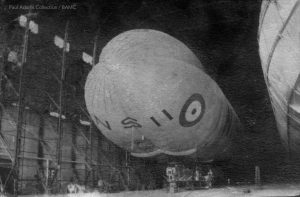 is in a pretty advanced stage of dismantlement in the photos so I would suggest it is June, 1919, just before N.S.11 left for Pulham.” The annotation below the top right photograph of HMA No 25 says, “Shower-aged outer cover removed”.
is in a pretty advanced stage of dismantlement in the photos so I would suggest it is June, 1919, just before N.S.11 left for Pulham.” The annotation below the top right photograph of HMA No 25 says, “Shower-aged outer cover removed”.
Top left is another photograph of N.S.11. The annotation is very faint. All that can be made out is “… shed”. Central to the page is a wonderful photograph titled “Merry Sergeants”. Their standard of dress, it has to be said, is very ‘relaxed’. Only one of the four men is wearing a complete uniform of some kind; the others are dressed in a combination of what looks like various items of uniform and ‘civvies’. Whether any of these men were members of N.S.11’s crew, we may never know.
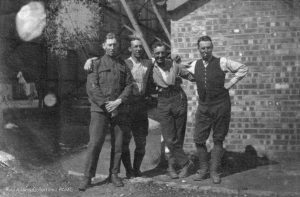 At this time the Armistice would have been seven months past and a question mark was hanging over the airship service. The Royal Air Force was also much slower to demobilise than the Army and Royal Navy, leaving many personnel and crew with little to do. In fact, at some airship stations there was unrest due to the slowness of ‘demob’.
At this time the Armistice would have been seven months past and a question mark was hanging over the airship service. The Royal Air Force was also much slower to demobilise than the Army and Royal Navy, leaving many personnel and crew with little to do. In fact, at some airship stations there was unrest due to the slowness of ‘demob’.
Bottom left of the page is a photograph of N.S.11 departing or, more probably, just landed after a flight. The pencil annotation here is very faint… “NS11 …. after … ..”.
‘Side two’ tells diff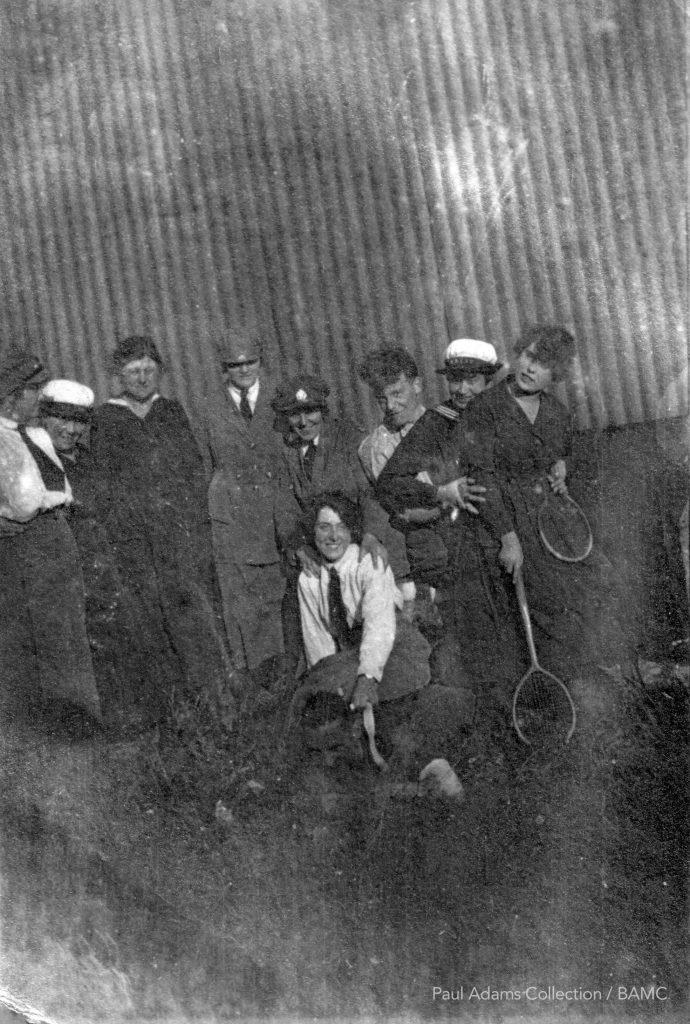 erent story. Apart from the central photograph of a happy man reclining on a ladder (“Flight Sgt Mjr Wilson” – we will track him down) the four other images feature the women of the airship service. There is very much a playful, summery atmosphere and a sense of ‘winding down’ in the photographs – tennis racquets, posing for photographs and ‘high jinks’ with the men. Another woman seems to be holding a shrub with its roots wrapped in cloth. Again, the women appear in a combination of WRNS and WRAF uniforms (they seem to have higher standards than the men). Women, both serving in the RNAS and WRAF as well as civilians, played a significant role in the airship service, as story we will look into in much detail in the near future.
erent story. Apart from the central photograph of a happy man reclining on a ladder (“Flight Sgt Mjr Wilson” – we will track him down) the four other images feature the women of the airship service. There is very much a playful, summery atmosphere and a sense of ‘winding down’ in the photographs – tennis racquets, posing for photographs and ‘high jinks’ with the men. Another woman seems to be holding a shrub with its roots wrapped in cloth. Again, the women appear in a combination of WRNS and WRAF uniforms (they seem to have higher standards than the men). Women, both serving in the RNAS and WRAF as well as civilians, played a significant role in the airship service, as story we will look into in much detail in the near future.
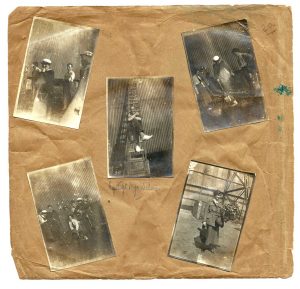 In the book Lost Voices of the Royal Air Force by Max Arthur there is an interesting comment from Private Phyllis Chambers… “They had the NS11 airship at Cranwell and we got to know all the boys. When it went off we waved farewell and shouted good luck. Unfortunately, it got struck by lightning over the North Sea. We all went into mourning for them, we were so sorry.”
In the book Lost Voices of the Royal Air Force by Max Arthur there is an interesting comment from Private Phyllis Chambers… “They had the NS11 airship at Cranwell and we got to know all the boys. When it went off we waved farewell and shouted good luck. Unfortunately, it got struck by lightning over the North Sea. We all went into mourning for them, we were so sorry.”
There is much more research to do on this item and this article will be updated to reflect that. Once again, we would like to thank Paul Adams and the British Airship Museum Cardington for their generosity in sharing this piece of history with us. For more information on the museum visit www.britishairshipmuseum.com

 NS11 – As Bright As Day is very much a work in progress and has been made possible by the generous and enthusiastic support of many individuals and organisations. If you have any information, records or material relating to British NS Class airships we would be very interested to hear from you – especially anyone related to members of the crew of NS11 or any airship of the class during their service with the RNAS or RAF during and beyond WWI.
NS11 – As Bright As Day is very much a work in progress and has been made possible by the generous and enthusiastic support of many individuals and organisations. If you have any information, records or material relating to British NS Class airships we would be very interested to hear from you – especially anyone related to members of the crew of NS11 or any airship of the class during their service with the RNAS or RAF during and beyond WWI.
Latest